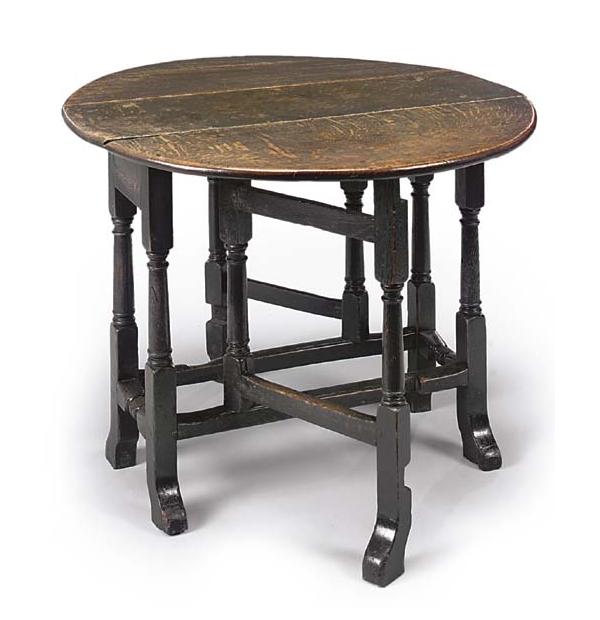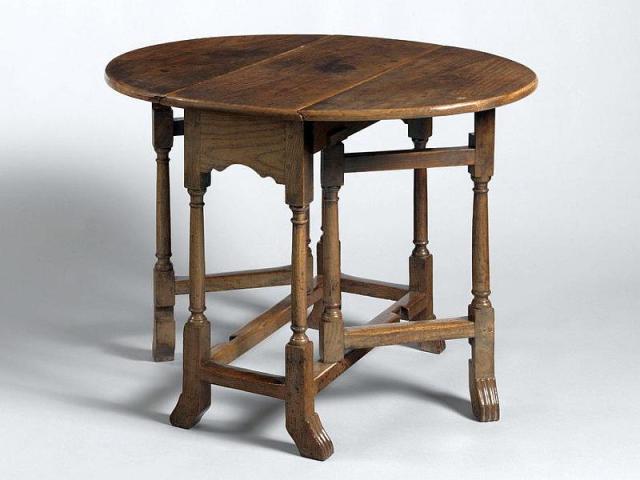Standing well short of the standard dining table height of 29-1/2″ (749mm), these diminutive gateleg tables were used by one or two persons for the purpose of taking tea or consuming informal meals in the privacy of a parlour or cabinet. At only 26″ (660mm) high, this Queen Anne elm gateleg table is at the lower end of the norm.
Fig. 1. Queen Anne elm gateleg table, circa 1710. (Robert Young)
I am intrigued by anomalies, eccentricities and idiosyncrasies encountered in British furniture: Tradition would dictate this table, like the thousands of other extant examples, should have been made of oak (fig. 2) – or occasionally fruitwood, walnut and yew – yet here is one beautifully made of elm.
 Fig. 2. Typical late seventeenth-century oak gateleg table.
Fig. 2. Typical late seventeenth-century oak gateleg table.
The elm table is of standard form with an oval top comprising a narrow fixed (centre) leaf flanked by two drop leaves which are supported in the open position by gates that pivot within the frame. The turnings on these little tables can easily look overwrought (fig. 3), but the restrained gun-barrel-turned legs of this elm table are quite elegant and terminate in braganza feet[1].
Fig. 3. Oak gateleg table, circa 1705. (Christie’s)
There is much planing of elm to be done.
Jack Plane
[1] Charles II (r. 1660 –1685) married Portuguese Catherine of Braganza, who is often credited with introducing the characteristic carved foot to England. However, the style of curlicue foot now commonly referred to as a Spanish foot, first appeared on English chairs during the first decade of the eighteenth-century.



Jack, Did the early makers mix woods? Although it would be neet to have some swirly grained elm for the top and leaves, it could also show off some quatersawn white oak. With the height around 26 inches, will the width/diameter of the top be around 26? legs? 1 1/2 by 3 (for the foot). Nice project looks like I have an addition to the list, have just the place for it.
Can’t wait to see the future posts and progress.
joe
LikeLike
Mixed woods are common in veneered furniture, but generally do not occur as frequently with solid wood tables like this, often being an indication of alteration or poor restoration.
The top is 34-1/2″ x 28-1/2″ and legs are 1-1/2″ square.
JP
LikeLike
“Informal meals in the privacy of a … cabinet.” I had a drink once in my drawers, but a cabinet sounds much more comfortable…especially one fashioned from Elm.
LikeLike
What… you’ve never had a party in a wardrobe? Isn’t ‘a drink in my drawers’ a bit Bear Grylls?
JP
LikeLike
One of the OED’s definitions of cabinet is ‘a small private room’.
LikeLike
I’m hoping you’ll share some tips on working elm with hand tools. I have some boards from an American Elm that died in our yard and tearout is a real problem. I finally got it smooth with a high bevel on my low angle jack plane but it’s a LOT of work pushing a steep edge though this wood
LikeLike
I’m afraid there are no secrets to working elm. It is an interlocked and contrary wood by nature – which virtue makes it eminently suitable for the seats of Windsor chairs. It is workable though with sharp blades and a little care.
JP
LikeLike
Is the elm lumber to be used the same elm that was being “overseen” by yourself last july 2012? Is that lumber ready? Dry? In the northeast US it takes quite a while to air dry lumber to a low enough moisture content be cause of the long winter season, Placing the lumber in an attic of a house or garage seems to finish it off after a year outside (4/4, more if thicker) usually I let it set for another year under those conditions and seems fine for use.
Which elm is to be used red,american, english wych? The photos from 2012 look a little like red elm because of the color.
LikeLike
No, the elm for this table is from the same lot I used for the elm dressing table I made early last year.
There are two naturalised elm species growing in Australia, English Elm (Ulmus procera) and Dutch Elm (Ulmus x hollandica).
JP
LikeLike
Hi Jack,
do you know if in past to make table top, or lids, or also something not constrained from joinery, the craftsmen altered the grow rings from board to board to restrain shrinkage?
Also, did they varnished the interior of drawers and panels for contain the shrinkage? Or do you think that it could be a good choice for didn’t have breakage in the pieces that after years cracked?
Thanks,
Valerio.
LikeLike
With joined (solid) timber table tops (and case furniture), priority was always given to appearance. Elsewhere, joined boards that were to be veneered were usually arranged with their grain running in the same direction for ease of planing.
The compartmented interiors of dressing drawers and bureaux were customarily polished, but generally speaking, the interiors of drawers and casework were never sealed.
JP
LikeLike
Thanks very much for reply, you are always a good source of helpful informations.
So when I see old (big) panelled furniture (say the rear of a wardrobe) with some big cracks (in big panels of pine, with some knots), I think that if the grain was sealed, the wood after years had cracked the same;
or maybe in simple furniture they used wood that wasn’t well seasoned.
LikeLike